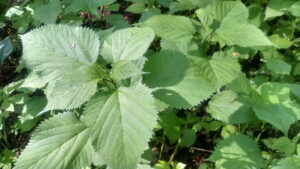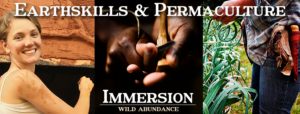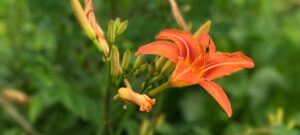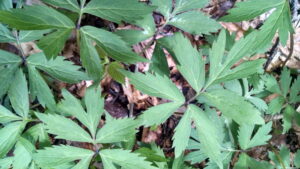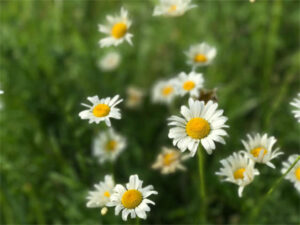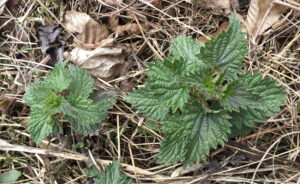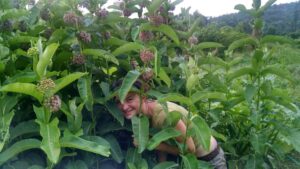Perennial vegetable plants come back year after year, without needing to be replanted. No beds to dig, no soil to prepare, just a little weeding and mulching from time to time. Sound too good to be true? They are pretty amazing. Indeed, perennial vegetables can be a wonderful addition to any food system, be it a backyard garden or a full-blown farm.
Here we’ll share a few of our favorite tried-and-tested perennial vegetables for this bioregion (the Southern Appalachian mountains); many are well-adapted to other places, too. For a primer on perennial crops in general (what they are, and why they are so great), check out our other post: Perennial Primer. And if you want to get to know these perennial treasures and others in person, consider joining us for our Permaculture Design Certificate immersion.
Ramps (Allium tricoccum)
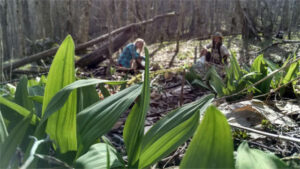
These delectable “wild leeks” are packed with pungent sweetness…like the lovechild of garlic, leeks and maple sugar. They grow wild in our mountains, but they can also be cultivated. In fact, you can transplant them from wild patches, or collect and sow seed. Ramps are a perennial vegetable that doesn’t do well in sunny garden conditions. In contrast, they like shady, moist, rich cove-forest conditions. Similar to their cousins (garlic and onions), ramps are great cooked in some kind of fat and added to just about anything. Dried ramps are tasty, too, and can be powdered and mixed with salt for an over-the-top condiment that also happens to be emerald green.
Note: If you harvest wild ramps, please consider cutting the leaves just above the tiny bulb, instead of digging up the whole plant. Ramps grow slowly and are gaining in popularity. As a result, over-harvesting is an issue. When you leave the bulb behind, you’re leaving the plant alive to continue its tenure in the wild and beautiful spot it calls home.
Daylily (Hemerocallis)
You may already know this one as a landscaping plant…you might have some growing in your yard! But did you know that it’s a perennial vegetable? Both the leaves and flowers (including buds) are tasty. Daylilies provide welcome freshness in early spring when garden plants usually haven’t come out yet. Greens should be picked young and cooked before eating; flowers and buds can be eaten raw. Orange flowers are ideal for eating. They like moisture and are happy in partial shade to full sun.
Note: Some people have an adverse reaction to one of the compounds found in daylilies. So, if it’s your first time trying them, just eat a small amount and see how you feel before really going for it.
Sochan (Rudbeckia laciniata)
A relative of echinacea, sochan is also known as yellow or cutleaf coneflower. It’s a native here and was used for food and as a medicinal herb by people indigenous to these mountains. Sochan has some of the same immune-boosting properties as its cousin echinacea, making it a perfect food to ward off springtime sniffles.
Young, tender leaves are delicious when steamed, sauteed, or added to soups and stews. Sochan also makes a great, peppy addition to pestos. This perennial vegetable is a sun-lover, although it will grow in partial shade, too. In summer, sochan adorns itself with many beautiful yellow (non-edible) flowers.
Oxeye Daisy (Leucanthemum vulgare)
This sweet little plant is technically a non-native “weed” from Eurasia, but it’s a polite guest. Oxeye daisy isn’t invasive or difficult to remove from places where it’s unwelcome. Additionally, it happens to be quite delicious, especially in fresh salads. The leaves, flower buds and flowers are all edible. We particularly like to pickle the flowers for a homegrown salad topping reminiscent of capers. This perennial vegetable thrives in garden-like conditions and on the forest’s edge.
Stinging Nettle (Urtica dioica)
Many people are familiar with stinging nettles as a medicinal herb, but did you know you can eat them, too? Nettles lose their sting once they’re cooked and have a deep, rich flavor. In addition, they’re extremely nutrient-dense, especially when it comes to minerals. Plus, this perennial vegetable is the most protein-rich of all leafy greens, comparable to beans or white-meat chicken.
Steaming, sautéeing, blanching and boiling are all good ways to cook nettles. Do keep in mind that their nutrient content (and flavor) are best preserved with light cooking; they’re superior when still bright green and vibrant.
Choose a place to plant nettles carefully, as they spread and can be hard to eradicate once they’re established. They like cooler, part-shade conditions with moist soil (in the wild, they’re found along creeks and streams), but they’ll also tolerate sun and drier conditions. As well as being nourishing food, stinging nettles provide a natural fiber (from their flower stalks) that can be corded into very fine string or rope.
Wood Nettle (Laportia canadensis)
This is our native nettle (Urtica dioica comes from Europe) and can be found here along creeks and streams in full shade. Wood nettle is also stingy, but much less so than its European cousin. Like stinging nettle, it’s delicious and nutritious and loses its sting upon cooking.
In comparison with Urtica dioica, our native nettle is more tender and will fall apart when overcooked; just a couple of minutes in a pan or steam basket is all that’s needed. Wood nettle doesn’t have the same medicinal properties as stinging nettle (although it is also a diuretic), nor does it spread and clump with as much vigor. It’s a bit less stingy and flowers later in the season, so we really like having both nettles around.
Cattail (Typha latifolia)
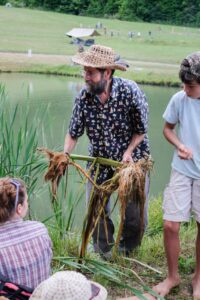

This is another familiar plant that you probably didn’t realize was edible. Many parts of this robust rush are wonderful to eat. The pollen can be collected and used in breads and cakes or as a thickener in soups. Additionally, the flower (cigar-shaped part) can be roasted and eaten when it’s young. What’s more, young shoots of cattail can be harvested and cooked like bamboo shoots, and the very tender young leaves can be eaten raw or lightly cooked. Finally, the rhizome itself is full of edible starch and can be turned into a flour by drying and then pounding.
Cattails live in ponds and marshy areas and can be quite invasive. If you’re planning to add this perennial vegetable to your garden or grounds, be sure to have a clear plan for keeping them in check (like regular harvesting for food).
Sunchoke a.k.a. Jerusalem Artichoke (Helianthus tuberosus)
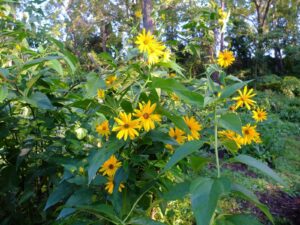

Neither an artichoke relative nor from Jerusalem, sunchokes are indeed a North American native in the sunflower family. Their tuberous roots can be cooked similarly to potatoes and have an artichoke-like flavor. It’s thought that the “Jerusalem” part of their common name comes from an adaptation of the Spanish word for sunflower: girasol.
This perennial vegetable is a very adaptable plant. In fact, it will grow almost anywhere. To thrive, it prefers full sun. While the tuberous roots are good food for people, the leaves are excellent fodder for livestock like goats and cows. Sunchokes are an especially excellent plant for permaculture gardens. Once you’ve got a patch established, they’re very hard to eradicate, and they spread. So, choose your planting location wisely. Also plan on regular harvesting for eating, or sharing tubers with friends so they can grow some, too.
Note: Sunchokes are very high in the prebiotic starch inulin. This starch is not easily digested by humans, but it’s great food for healthy gut microbes. Many people experience gas and bloating if they eat large amounts of inulin, especially the first time. We recommend eating small amounts of sunchokes at first and seeing how you feel. Long, slow-roasting will break down some of the inulin. This is the traditional method of preparation by some North American native people.
Milkweed (Asclepias syriaca)
Monarch butterflies aren’t the only creatures who love milkweed. You may have heard that this beautiful plant is poisonous, which is true of its milky latex. But don’t despair: the the flower buds, shoots, flowers, and the young pods can be eaten and enjoyed if you cook or ferment them to remove their toxins. In fact, all these parts are delicious and add intrigue and aroma to any dish you put them in.
We particularly like egg omelets with milkweed buds and adding young pods to brothy noodle soups. This is a native wild plant, and you may find it growing in old fields and “waste places.” When you do, don’t hesitate to dig up a few plants and transplant them into kinder conditions in your garden. They thrive and can grow very tall in rich soil. Of course, a bonus of this perennial vegetable is that pollinators love it too, especially butterflies.
Basswood a.k.a. American Linden (Tilia americana)
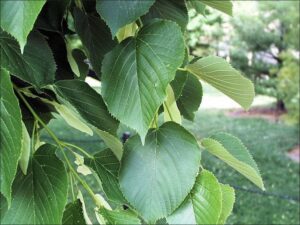

Not too many trees are considered vegetables, but young basswood leaves are so tender and delicious that this one made the cut. Tilia americana grows wild in our forests. At the Wild Abundance campus, we’ve managed them by pruning away competition to provide more light, and by cutting them back to encourage new growth that is lower and easier to access. Basswood trees can also be planted if you don’t have woods nearby, but keep in mind they do grow quite large.
In early to mid-spring, the tasty leaves of this perennial vegetable can be harvest in great quantities (if you have access to low-hanging branches or are keen to climb trees). They’re delicious eaten fresh, or, better yet, lightly steamed. We prepare a dolma-inspired dish of steamed, stuffed basswood leaves that’s quite a conversation piece at dinner parties. Basswood leaves aren’t as tough as grape leaves, so if you’d like to try these wild dolmas, cook the filling before stuffing and steaming them.
Recommended Resources
If you want to find these books locally, more power to you! If you want to buy them online, we participate in an affiliate program with Amazon.com, and when you click on the links below, we benefit. The money that we make from this program goes into a fund to help us continue to offer free information to everyone.
Perennial Vegetables: From Artichokes to Zuiki Taro, A Gardener’s Guide to Over 100 Delicious and Easy to Grow Edibles by Eric Toensmeier
How to Grow Perennial Vegetables: Low-Maintenance, Low-Impact Vegetable Gardening by Martin Crawford
The Resilient Farm and Homestead: An Innovative Permaculture and Whole Systems Design Approach by Ben Falk
The Carbon Farming Solution: A Global Toolkit of Perennial Crops and Regenerative Agriculture Practices for Climate Change Mitigation and Food Security by Eric Toensmeier
The Holistic Orchard: Tree Fruits and Berries the Biological Way by Michael Phillips
Creating a Forest Garden: Working with Nature to Grow Edible Crops by Martin Crawford
Gaia’s Garden: A Guide to Home-Scale Permaculture, 2nd Edition by Toby Hemenway
